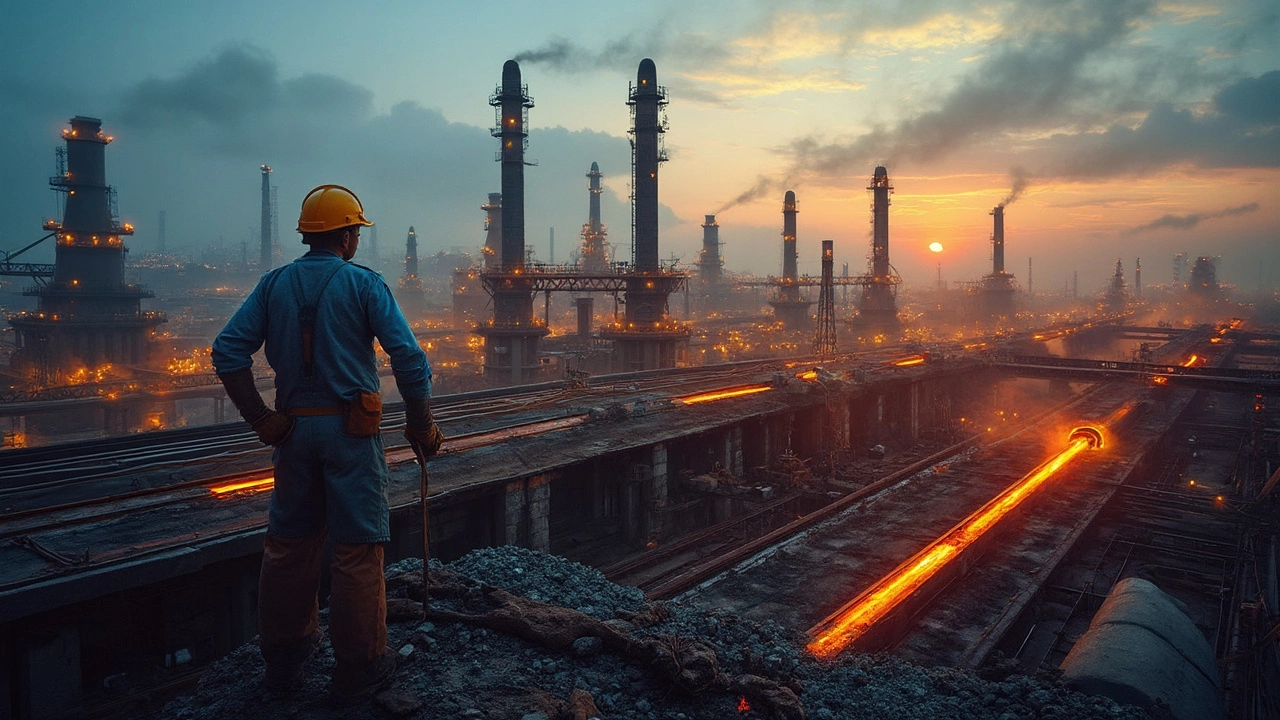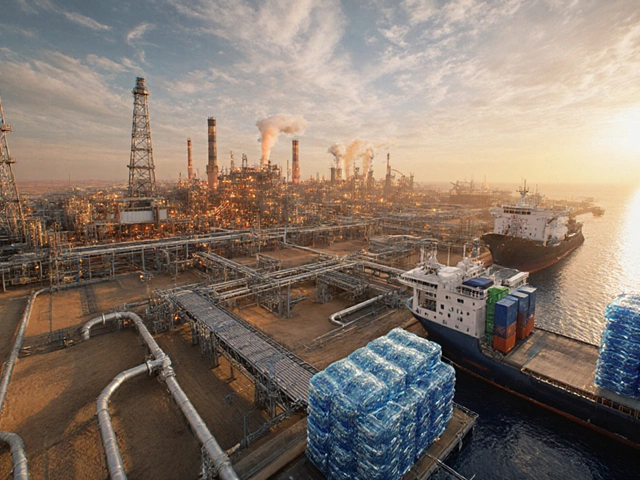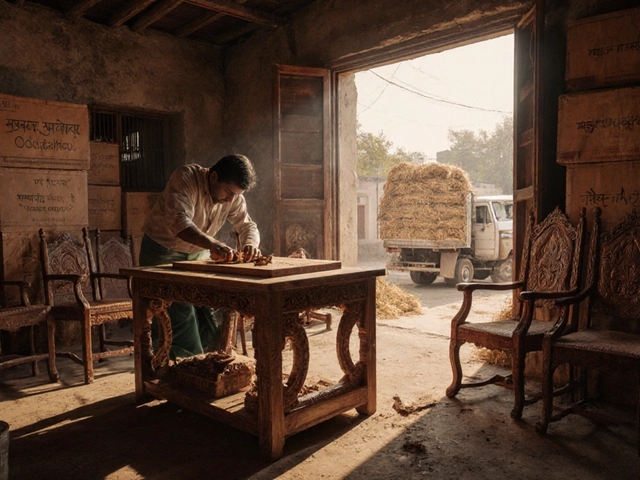Who first cooked up steel? You might picture a lone genius in a lab, but steel’s birth is messier than that. People have been messing with iron and carbon for thousands of years, long before anyone bothered to write patents or shake hands on a deal. Ancient blacksmiths in places like India and China were making basic types of steel over two thousand years ago—long before big steel plants or blast furnaces ever existed.
Steel isn’t really a one-person invention. It’s a mix of luck, skill, and a whole lot of trial and error. The secret? Getting just the right amount of carbon into iron. Sounds easy, but it took centuries for folks to nail the trick and scale it up in huge factories. The real magic happened when people stopped making tiny batches and figured out how to churn out mountain loads of steel at once.
If you’re around steel manufacturing or you’ve ever set foot near a steel plant, you’ve probably seen the result of this long, tangled story. Knowing a bit about where and how it all started helps make sense of today’s high-tech factories and their wild output. Plus, it comes in handy whether you’re buying raw steel, picking a plant to work with, or just wanting to know what actually goes into those skyscrapers and cars scattered all over the place.
- Steel Before It Had a Name: Early Discoveries
- The Industrial Leap: Modern Steel’s True Roots
- Steel Manufacturing Plants: Game Changers in Production
- Surprising Facts: Myths, Mistakes, and Modern Surprises
- Tips for Navigating the Modern Steel World
Steel Before It Had a Name: Early Discoveries
Steel’s story doesn’t start in some fancy factory but in ancient fire pits and backyard forges—seriously low-tech places compared to today’s steel manufacturing plants. The first known steel makers were working with the basics: iron ore, charcoal, and simple bellows. But even with those rough tools, some got it right.
The evidence? Archaeologists dug up steel objects in what’s now India, dating back to about 400 BCE. These folks made “Wootz” steel, famous for its sharp blades and crazy durability. This stuff was hyped all over the ancient world. Romans and Arabs traded for it, and even the legendary Damascus swords used Wootz as the secret ingredient.
Meanwhile, in China around 200 BCE, inventors were using blast furnaces to make pig iron, then fiddling with temperatures and mixing to get an early version of steel. The difference was, they went bigger—making more in less time. Ethiopia and parts of Africa had their own methods, too, quietly cooking up high-carbon steel in clay furnaces a thousand years ago.
Here’s a quick look at some early steel hotspots:
| Place | Rough Date | What They Did |
|---|---|---|
| India (Wootz) | ~400 BCE | Created legendary steel ingots with extreme edge retention |
| China | ~200 BCE | Used blast furnaces to mass-produce early steel |
| Africa (Ethiopia) | ~500 CE | Forged high-carbon steel with unique clay furnace methods |
| Middle East | ~1000 CE | Spread knowledge of steelmaking for swords and armor |
If you look closer, no single country “invented” steel; different places figured it out in their own way. What they all shared was the real breakthrough: mixing just enough carbon with iron to make it tough, flexible, and, back then, almost priceless. No “inventor,” just smart people getting creative with hot metal and new ideas—centuries before anyone thought to call it ‘steel’ at all.
The Industrial Leap: Modern Steel’s True Roots
Steel’s real shift didn’t happen in ancient forges but in the middle of the 19th century, and it was all about getting efficient. The steel that shapes buildings and highways today comes from breakthroughs that started in England with a guy named Henry Bessemer. In 1856, Bessemer stumbled onto a method to pump air through molten iron, which kicked out impurities and gave the world a cheap, quick way to make strong steel. He wasn’t the only one tinkering—William Kelly, over in the US, was working on a similar idea at the exact same time. But Bessemer’s process caught on first, sending the steel industry into overdrive.
If you want to see how single changes rocked an entire industry, just look at plant output before and after Bessemer. Where old ways could make a couple hundred pounds a day, the Bessemer converter made tons in a blast. Prices dropped so much, railroads, skyscrapers, and bridges could suddenly sprout up everywhere. To quote historian Donald McCullough:
"The Bessemer process didn’t just make more steel, it rewrote the rulebook for building the modern world. Steel turned from a luxury product to an everyday material."
This leap didn’t stop there. The open-hearth process arrived soon after, letting plants recycle scrap metal and control quality even better. By the early 20th century, steel mills were running hot in the U.S., Europe, and Japan, some cranking out millions of tons every year.
| Year | Major Process | Typical Annual Plant Output (Tons) |
|---|---|---|
| 1850 | Pre-Bessemer | ~500 |
| 1870 | Bessemer Converter | ~50,000 |
| 1920 | Open-Hearth | 100,000+ |
Big takeaway: modern steel is all about volume and consistency. The methods born from the industrial leap still define how today’s steel manufacturing plants run, just with more automation, better safety, and stricter quality control.

Steel Manufacturing Plants: Game Changers in Production
There’s nothing ordinary about a steel manufacturing plant. These places don’t just melt and mold metal; they transformed what was once back-breaking, small-scale work into a global powerhouse industry.
The real game-changer hit in the mid-19th century: the Bessemer process. Henry Bessemer’s invention in England meant that, for the first time, you could pump air through molten pig iron, burn off the bad stuff, and crank out steel faster and cheaper. Steel stopped being a rare, luxury material and basically became the backbone of modern cities and transportation overnight. By 1870, most big plants in Britain, Germany, and the US had some version of the Bessemer converter.
Not long after, the open-hearth furnace took the stage, letting folks fine-tune the quality and create even bigger batches. Then came the basic oxygen furnace (BOF) in the 1950s, which could turn iron into steel in 20-40 minutes—a huge leap compared to the hours or days older methods took.
- The first full-scale Bessemer plant in the US launched in Troy, New York, in 1865.
- Today, most new steel comes from BOF or electric arc furnaces (EAFs). EAFs especially shine at recycling old steel, making them hits in countries focused on sustainability.
Here’s a quick look at how production methods compare in modern plants:
| Method | First Used | Time to Produce Steel (per batch) | Main Use |
|---|---|---|---|
| Bessemer Process | 1856 | 20-30 min | Mass production, rails, beams |
| Open-Hearth | 1865 | 8-12 hours | Custom alloys, big projects |
| Basic Oxygen Furnace | 1952 | 20-40 min | Modern mass production |
| Electric Arc Furnace | 1907 | 50-60 min | Recycling, specialty steels |
Factories today look like small cities: conveyors, furnaces, rolling mills, and labs working 24/7. They make everything from car parts to massive bridge beams, often using robots and computer controls to keep quality up and waste down. Fun fact—about 70% of steel made in the US now comes from recycled scrap, thanks mostly to the rise of EAF plants.
For anyone working in or dealing with steel plants, the magic is in the details: which process they use, how they source material, and how they keep costs—and pollution—low. If you’re chasing the best price or planet-friendly options, asking about their main process is a smart first step.
Surprising Facts: Myths, Mistakes, and Modern Surprises
Let’s clear up a big one first—no single person can claim to have invented steel. You’ll hear that Henry Bessemer “invented steel” in the 1850s, but he actually came up with a process to make it cheaper and faster. People in India were making Wootz steel, a super-strong metal, way back in the third century BC. Archaeologists found evidence of steel tools in places like Turkey and China, too. So, steel’s history is owned by a crowd, not a celebrity inventor.
Here’s a wild fact: Early steel production was hit-and-miss. For centuries, nobody really knew what made some batches of iron mysteriously stronger, and others turn out brittle. Even factories struggled at first. When the first Bessemer converters fired up in England, big companies lost a lot of cash because they didn’t realize the process only worked well for some types of iron. One misstep and boom—worthless steel.
Some folks believe steel is always super heavy, but it’s not. Actually, modern steel can be rolled thin enough to float on water. Today’s advanced steel grades are lighter and stronger than some aluminum blends. Factories use computer-controlled systems to tweak recipes to the tiniest detail. That’s the only way they hit today’s wild accuracy and strength.
“Steel has gone from a backyard experiment to a core ingredient in our cities, cars, and gadgets. The leap from small-scale to massive production changed the world in ways no one could predict.” — Dr. John Speer, Director, Advanced Steel Processing and Products
Factories these days sometimes brag about being ‘green’ steel plants. That means cutting emissions, recycling more scrap, and swapping out coal for cleaner tech. For example, in 2024, SSAB’s Swedish plant claimed to produce the world’s first fossil-free steel, made using hydrogen instead of coke. Not just hype: early tests showed CO2 emissions kept under 2% of the normal level for regular steel furnaces.
| Fact | Year/Source |
|---|---|
| Bessemer Process Patented | 1856, UK |
| First Commercial Fossil-Free Steel | 2024, SSAB Sweden |
| Ancient Wootz Steel Found | c. 300 BC, India |
| Modern Steel Types Produced Yearly | Over 3,500 (World Steel Association, 2023) |
Thinking today’s steel is just ‘better iron’ misses the point. Modern plants can make thousands of wildly different steel types for everything from scalpels to skyscrapers. It’s not magic, just a crazy amount of brainpower, trial and error, and—yeah—machines the size of football fields. Next time you walk by a steel beam or a car, know it’s the result of thousands of years of tweaking, mistakes, and those rare home runs that push the whole industry forward.

Tips for Navigating the Modern Steel World
Finding your way in the steel business isn’t just about knowing what steel is. There’s a sea of choices, from different grades and specs to plant capabilities and environmental standards. Here’s how to stay sharp when dealing with modern steel manufacturing plants:
- Know what you need. Start with the basics—do you want carbon steel, stainless steel, or something specialty? Construction and auto parts often use steel grades like A36 or 1018, while kitchenware and tools usually call for stainless. If you get the grade wrong, you could end up with steel that rusts or can’t handle the job.
- Pick the right plant. Not all plants are equal. Some specialize in bulk orders, others focus on custom alloys or fast turnaround. If you need steel for huge construction projects, look for plants with blast furnaces or electric arc furnaces. Smaller jobs might be better with a mini mill.
- Check quality standards. Watch for ISO certifications or ASTM ratings. A plant that skips these is a red flag. These standards keep you safe and make sure you get what you paid for.
- Think green. The steel world is shifting toward greener tech. Big plants in Europe, like ArcelorMittal and SSAB, are already making "green" steel with way less CO2. Choosing plants using recycled scrap or hydrogen-based reduction cuts your carbon footprint by up to 90%.
- Spot hidden fees. Always double-check the quote. Freight, cutting, and finishing can add up fast. Get the full breakdown before signing anything—it’s surprising how often newbies get tripped up here.
The steel industry is massive. Here’s a breakdown of global steel production leaders from 2023, in million metric tons (MT):
| Country | Crude Steel Output (MT) |
|---|---|
| China | 1,019 |
| India | 140 |
| Japan | 87 |
| United States | 80 |
| Russia | 74 |
If you’re new, don’t be afraid to ask plants about lead times, compliance, and recycling practices. There’s a lot of old-school lingo, but most reputable steel plants are used to all levels of questions. Before you decide, tour the plant if possible—seeing their process up close can save you trouble later.
Dealing with steel may look complicated, but once you know what to ask for and what red flags to watch out for, you’re in a good spot. Sometimes, the guy who asks the "obvious" questions is the smartest one in the room.











Write a comment